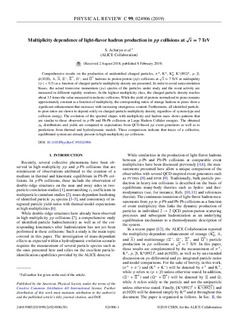Multiplicity dependence of light-flavor hadron production in pp collisions at √s=7 TeV
Acharya, Shreyasi; Acosta, Fernando T.; Adamová, Dagmar; Adler, Clemens; Adolfsson, Jonatan; Aggarwal, Madan M.; Aglieri Rinella, Gianluca; Agnello, Michelangelo; Agrawal, Nikita; Ahammed, Zubayer; Alme, Johan; Altenkaemper, Lucas; Djuvsland, Øystein; Ersdal, Magnus Rentsch; Fionda, Fiorella Maria Celeste; Nystrand, Joakim; Rehman, Attiq ur; Røhrich, Dieter; Tambave, Ganesh Jagannath; Ullaland, Kjetil; Wagner, Boris; Yuan, Shiming; Zhou, Zhuo; Arsene, Ionut Cristian; Bätzing, Paul Christoph; Dordic, Olja; Lardeux, Antoine Xavier; Lindal, Svein; Mahmood, Sohail Musa; Malik, Qasim Waheed; Richter, Matthias; Røed, Ketil; Skaali, Toralf Bernhard; Tveter, Trine Spedstad; Wikne, Jon Christopher; Zhao, Chengxin; Helstrup, Håvard; Hetland, Kristin Fanebust; Kileng, Bjarte; Nesbø, Simon Voigt; Storetvedt, Maksim Melnik; Langøy, Rune; Lien, Jørgen; Ahn, Sang Un; Aiola, Salvatore; Akindinov, Alexander; Al-Turany, Mohammed; Alam, Sk Noor; De Albuquerque, Danilo Silva; Aleksandrov, Dimitry; ALICE, Collaboration
Journal article, Peer reviewed
Published version
Permanent lenke
http://hdl.handle.net/11250/2599085Utgivelsesdato
2019Metadata
Vis full innførselSamlinger
- Institutt for mikrosystemer [522]
- Publikasjoner fra CRIStin [3416]
Sammendrag
Comprehensive results on the production of unidentified charged particles, π ± , K ±, K0S, K∗ (892) 0, p, ¯p, ϕ (1020), Λ, ¯¯¯Λ , Ξ −, ¯¯¯ Ξ +, Ω −, and ¯¯¯Ω + hadrons in proton-proton (pp) collisions at √s=7 TeV at midrapidity ( |y| < 0.5) as a function of charged-particle multiplicity density are presented. In order to avoid autocorrelation biases, the actual transverse momentum (pT) spectra of the particles under study and the event activity are measured in different rapidity windows. In the highest multiplicity class, the charged-particle density reaches about 3.5 times the value measured in inelastic collisions. While the yield of protons normalized to pions remains approximately constant as a function of multiplicity, the corresponding ratios of strange hadrons to pions show a significant enhancement that increases with increasing strangeness content. Furthermore, all identified particle-to-pion ratios are shown to depend solely on charged-particle multiplicity density, regardless of system type and collision energy. The evolution of the spectral shapes with multiplicity and hadron mass shows patterns that are similar to those observed in p-Pb and Pb-Pb collisions at Large Hadron Collider energies. The obtained pT distributions and yields are compared to expectations from QCD - based pp event generators as well as to predictions from thermal and hydrodynamic models. These comparisons indicate that traces of a collective, equilibrated system are already present in high-multiplicity pp collisions.
Beskrivelse
Published by the American Physical Society under the terms of the Creative Commons Attribution 4.0 International license. Further distribution of this work must maintain attribution to the author(s) and the published article's title, journal citation, and DOI.

